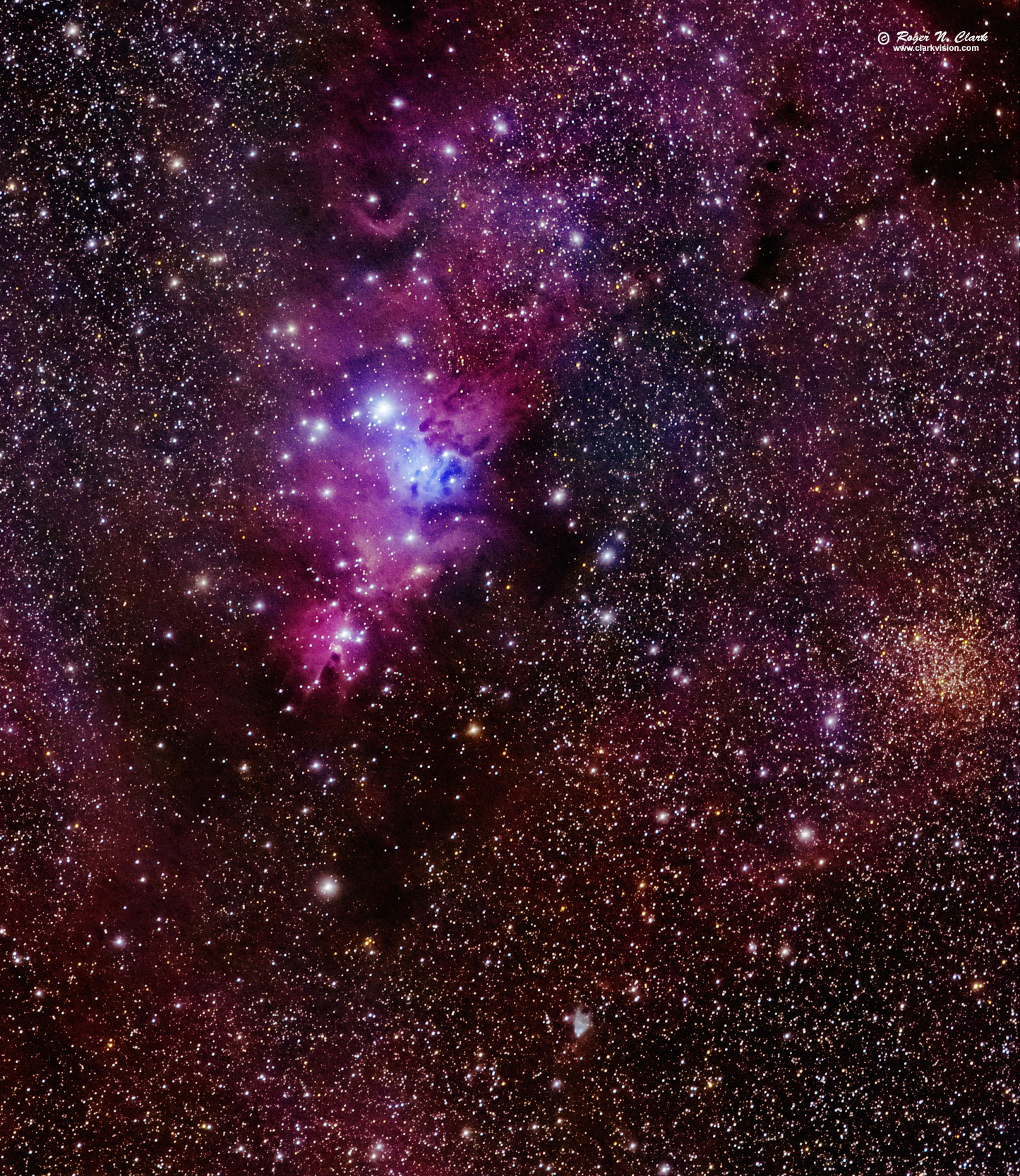| Home | Galleries | Articles | Reviews | Best Gear | New | About | Contact | Gallery Index | Previous |
Next |

| Home | Galleries | Articles | Reviews | Best Gear | New | About | Contact | Gallery Index | Previous |
Next |

This region of the constellation of Monoceros includes the galactic plane of the Milky Way and beautiful mixtures of pink-magenta hydrogen emission nebula that with young star-forming areas, blue reflection nebulae, and old star clusters. The region around the Cone nebula, NGC 2264, (the bottom end the pink-magenta nebula left of center) includes the Fox-Fur nebula (above the light blue at center with the many small dark patches), the Christmas Tree cluster in the center (upside down in the north is up view), and at right are the yellow stars of the old (~3 billion years) open star cluster Trumpler 5. The small comet-shaped Hubble's Variable nebula (NGC 2261) is at the lower center-right.
Technical. Canon 7D Mark II 20-megapixel digital camera and 300 mm f/2.8 L IS II at f/2.8. One Hundred and six 1-minute exposures at ISO 1600 were added (106 minutes total exposure). No dark frame subtraction, no flat fields, no noise reduction. Tracking with an astrotrac. The image was made in Hawaii over 2 warm nights and trade winds shaking the setup. Out of many images, I was only able to use 106 frames--those without wind shake. The warm environment raised the sensor temperature to 33 degrees Centigrade, so dark current, light pollution, and vog from the erupting volcano on the island all limited how faint I could image. Still, this faint nebula demonstrates that the 7D Mark II is an amazing low light camera for it to record so much detail in this exposure and environment. Full size image is at 2.8 arc-seconds per pixel, and the image here is 60% of full resolution and slightly cropped. Thus, plate scale on this image is 4.7 arc-seconds per pixel.
The Exposure Factors, CEF, CEFA are measures of the relative amounts of light received from a subject. It can be used to fairly compare wildly different lens/telescope apertures and exposure times. For this image:
Modern DSLRs like the 7D Mark II include on sensor dark current suppression and low fixed pattern noise at ISOs around 1600 and higher, making no need for dark frame subtraction. Modern raw converters correct for light fall-off and also correct for hot/dead/stuck pixels. This makes processing low light images easy: simply align and average. See my series on Astrophotography Image Processing and Image Sharpening for more details.
The color balance is close to true color, meaning this is a stock camera with very close spectral response similar to the human eye. Astrophotographers often modify cameras for increased sensitivity to Hydrogen-alpha emission (red). Hydrogen emission nebulae actually appear pink due to H-alpha (red), H-beta (blue) and emission from other atoms, like oxygen and sulfur. Modified cameras over emphasize H-alpha, making hydrogen emission nebulae come out red in photos. Unmodified cameras do a better job at color separation of the various processes that occur in the deep sky.
To learn how to obtain stunning images like this, please visit my Extensive Articles on Photography .
See my review of the Canon 7D Mark II and why it is so good for astrophotography: Canon 7D Mark II sensor analysis.
Keywords to this image = astrophoto-1 nebula low-light digital_astro canon_7d2
Image ID: cone-nebula.300mm.c02.01-2.2016.106m.0J6A7104-489.m-c1-0.6xs.jpg
| Home | Galleries | Articles | Reviews | Best Gear | Science | New | About | Contact |
Last updated May 24, 2025